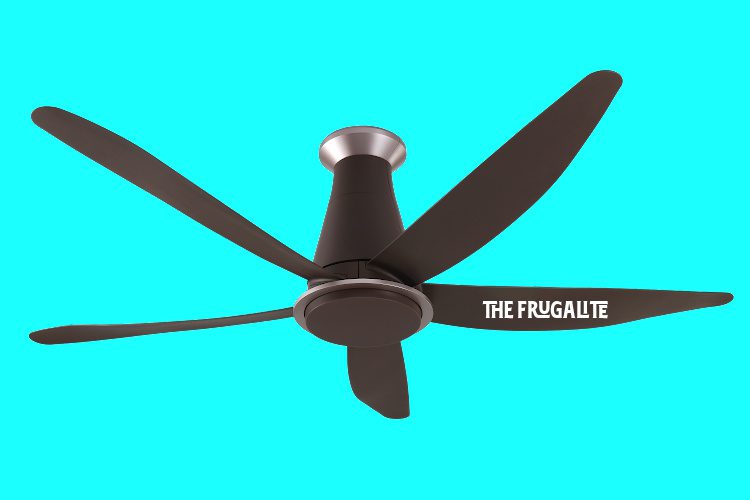(Psst: The FTC wants me to remind you that this website contains affiliate links. That means if you make a purchase from a link you click on, I might receive a small commission. This does not increase the price you’ll pay for that item nor does it decrease the awesomeness of the item. ~ Daisy)
By Handy Fran
EDITOR’S NOTE: What do you think about a new how-to series? There are tons of tasks I always wanted to do but didn’t know how. If I had to pay for them to be done the savings would have taken a long time to be realized. But if I could do them myself, it would have made a big difference. Let us know what you think after reading this installment of The Handy Frugalite, with our new contributor, Handy Fran. ~ Daisy
Installing a ceiling fan is a relatively simple DIY project that can help improve the airflow and circulation in your home. This saves money on your utility bills, which is really important right now.
However, just because it’s easy doesn’t mean you can be sloppy. It’s important to follow proper safety procedures and use caution while working on any electrical project.
Before you start…
Warnings and Helpful Hints
Please take this seriously.
- Make sure to turn off the power to the circuit before working on the electrical connections.
- Use caution when working on ladders or with heavy objects like a ceiling fan.
- If you’re unsure about any part of the installation process, it may be a good idea to hire a professional electrician to install the ceiling fan for you.
- If you notice any issues with the fan, such as wobbling or strange noises, stop using the fan and consult a professional for help.
Some additional helpful hints:
- Make sure to read and understand the manufacturer’s instructions before beginning the installation process.
- If you’re installing a ceiling fan in a room with a high ceiling, it may be a good idea to use a ceiling fan mounting kit with an extension downrod to adjust the height of the fan.
- If you’re installing a ceiling fan in a room with a sloped ceiling, you’ll need to use a ceiling fan mounting kit that’s designed for angled ceilings.
- If you’re installing a ceiling fan where there was no previous lighting fixture, you’ll need to run electrical wiring to the ceiling and install a junction box before installing the fan. This is a more advanced electrical project, and it may be a good idea to hire a professional electrician to do this for you.
What you need to install a ceiling fan
Gather all the tools and materials you’ll need for the installation.
You’ll need
- a drill
- the appropriate screwdriver
- a wire stripper
- wire nuts
- a voltage tester
- the ceiling fan mounting kit.
It’s also a good idea to have a ladder and it’s way easier with a helper to assist with the installation.
Here’s a step-by-step guide on how to install a ceiling fan:
Here’s what you do next.
Turn off the power to the ceiling fan location. Before you begin any electrical work, it’s important to turn off the power to the circuit that supplies electricity to the ceiling fan. You can do this by flipping the switch on the circuit breaker or removing the fuse from the fuse box.
Remove the old light fixture or mounting plate. If there is an existing light fixture or mounting plate on the ceiling, you’ll need to remove it to make room for the new ceiling fan. Carefully remove any screws or mounting hardware, and gently lower the fixture or plate to the ground.
Assemble the ceiling fan according to the manufacturer’s instructions. Most ceiling fans come with a mounting bracket and installation instructions. Carefully follow the instructions to assemble the fan and mounting bracket, taking care not to damage any parts or wires.
Install the ceiling fan mounting bracket. Use a drill to attach the mounting bracket to the ceiling joists. Make sure to use screws that are long enough to securely hold the weight of the fan, but be careful not to overtighten and strip the wood.
Connect the wires from the ceiling to the fan. You’ll need to connect the black or red wire from the ceiling to the black or red wire on the fan, the white wire from the ceiling to the white wire on the fan, and the green or bare wire from the ceiling to the green or bare wire on the fan. Use wire nuts to secure the connections, and wrap the connections with electrical tape to prevent any shorts.
Install the fan blades and motor housing. Follow the manufacturer’s instructions to attach the fan blades and motor housing to the mounting bracket. Make sure to secure the blades and housing firmly to prevent any wobbling or shaking.
Test the fan to make sure it’s functioning properly.
Turn the power back on and use a voltage tester to confirm that the electrical connections are secure. Use the fan’s pull chains or remote control to turn the fan on and off and adjust the speed. If everything is working properly, you’re ready to enjoy your new ceiling fan!
You’ve got this!
Installing a ceiling fan can be a simple and cost-effective way to improve the circulation and airflow in your home. With a little bit of care and attention to detail, you can easily install a ceiling fan and start enjoying the benefits of a more comfortable and efficient home. So go ahead and give it a try – you’ll be surprised at how easy and rewarding it can be!
Have you ever installed a ceiling fan? Do you have any tips to add? Let’s talk about it in the comments.
About Fran
Handy Fran is a grandmother in the Midwest who enjoys puttering around her suburban home. She discovered her knack for home repair when she was in her 20s and has been cheerfully fixing things ever since.












3 thoughts on “How to Install a Ceiling Fan: The Handy Frugalite”
Installing any ceiling fan is just a part of the possible challenges. That gives you an opportunity to learn if the house builder originally botched the house wiring — including connecting pieces of various rooms wiring never disclosed on the wiring diagram never provided to the naive home buyer. I didn’t learn until some 30 years later that my builder had secretly connected the garage wiring to the utility room, one bedroom, and just half of another bedroom. So troubleshooting a partly or non-working ceiling fan might involve figuring out the house wiring diagram that the builder never wanted you to have.
You need to find out if the breaker box (usually in the garage) has the breaker switches correctly labeled — if at all. You definitely need to learn which breaker switch kills power to the wiring which will connect to your new ceiling fan.
In addition to bungled wiring design … switches can wear out over time, or just partly wear. House wiring can be damaged sometimes if other gadgets short out. So the initial installation is just the beginning of some possible lifelong challenges.
One way to judge whether you are up to the task of freshly installing a new ceiling fan is to run this CEILING FAN INSTALLATION search phrase on YouTube.com. That will pull up many related how-to videos to help give you a good idea of whether you want to tackle that challenge … or simply contract it out.
–Lewis
Welcome Fran! I really dislike working with electricity, but can if I need to. I live in an older home so can appreciate Lewis’ comments about bungled wiring and un- or mis-labeled breakers! That said, I did help my late DH install our ceiling fans. Not confident enough to do it myself but think I could figure it out! Looking forward to future DIYs from you!
DIY is great BUT one has to know his/her/their limitations (and local regulations if said DIY project is in the field of view so to speak.
And yes do make sure your breaker box is marked but as another poster stated, use caution when it comes to all things electric.